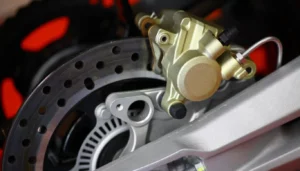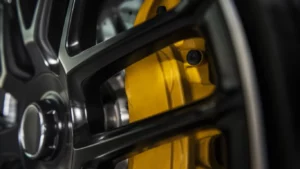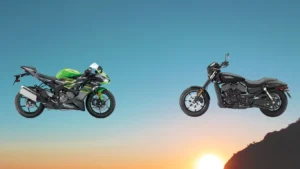On the road, you are free to ride any type of bicycle, with the exception of dirt bikes. Dirt bikes are designed in such a way that they are lightweight. As a result, they do not have headlights, indication lights, or brake lights. Riding a motorcycle on the road without these lights can be extremely hazardous and even life-threatening.
So the answer is No, you cannot ride dirt bike on the road.
I can understand the pain of a dirt bike rider who can’t enjoy the fun on the street while riding the bike. The manufacturing of this bike is such that it is dangerous to ride on the road.
However, you can ride it in local areas, near parks, or hilly mountains.
To begin, it is essential that you know the rationale behind the prohibition of riding a dirt bike on the road. It does not have any headlights, turn signals, brake lights, or a stand, and because of this, riding a bike on the road with it is an extremely hazardous endeavor.
The person who is following you on your bike can become perplexed if you make an abrupt turn or if you halt in the middle of the road.
As a direct result of the repercussions, an accident occurred, which also caused damage to the automobiles.
If interested riding at night you should read how to put headlight on a dirt bike?
Where Are You Allowed To Ride A Dirt Bike?
In this era, legally finding fun is a little bit tough, but still, you can ride your dirt bike legally.
You probably can’t but can ride it some other places where you will enjoy it a lot. Here, I’m listing a few places best for riding a dirt bike.
1. Your Private Property
I know having a dirt bike means you are wealthier and also have a large property. You may have a farmhouse or a big backyard to play with.
Use these areas to enjoy your day with a dirt bike. Nobody is going to interrupt you, and driving there it is legal.
2. Private Motocross Track
This track is specially made for dirt bikes; you need to get permission to enter this place.
You will have a great experience with the motocross track, yeah there are some public tracks too, but you may not get satisfaction in the crowd.
But, if you are still in your learning stage, it is better to avoid tracks.
3. Trail Areas
This one could be the best place to ride a dirt bike. But before visiting this place, check its rules & regulations. Some trails allow certain kinds of bikes or require documents.
If you are allowed for state trails, take your helmet for safety as such areas are too rough.
So, you came to know about those places where you are easily allowed to ride a dirt bike.
What Happens If I Ride A Dirt Bike On The Road?
If you ride your dirt bike without making it street legal will cost you so high. It comes under a crime; you may be charged or put in jail(for any major incident).
You must know whether do you need to make a dirt bike street legal or not?
When a cop arrests you, they directly go to the magistrate, where you need to explain why you do so. Even if the case is tough, it will cancel your license, vehicle registration belonging to other bikes. You can imagine how much this mistake gives stress.
How Do I Make My Dirt Bike Street Legal?
Although dirt bikes are not permitted for road riding, you can make it possible with some changes and legal documents.
What is the mechanical equipment you need, and which documents will help make your dirt bike street legal?
I bet you, after gaining the knowledge about street legal bikes, you won’t ask how to make a dirt bike street legal and ride it on local areas.
For necessary equipment, you must have below listed things:
1. A Headlight with accurate beam
The first and basic requirement of street-legal bikes is that it has a headlight. According to law, headlights resist accidents.
In the dark, others can easily see and don’t collapse. Headlights are also helpful in finding the path towards your destination.
Some states or countries allow switch headlights to change the beam from low to high and vice versa. When you buy the light, check this system to avoid further troubles.
2. Turn signals for both (left & right)
How do you know the guy riding on the bike will turn, of course, from the turn signals. But what if it is a dirt bike, that’s why the law says install turn signals which work for both left & right.
Usually, dirt bike riders communicate with each other using hands while turning the bike. It’s not possible for the roads; even the police can pull away from your bike. One more best thing about turn signals is that people behind you will understand where you will turn during bad weather.
3. Brake Light
If you have more experience, you must have seen such a quarrel where two people are fighting because one of them doesn’t see the brake light and hits the front one’s vehicle.
As the dirt bike department says, attach a brake light so that you will be safe from unwanted hits behind the bike.
4. Horn System
Put these instructions in your mind; you will ride your bike on the road, not in your locality, where you can shout to make someone aware that you need room to ride your dirt bike.
The same dirt bike department passed a law in which the horn is equally important as the headlight. When it comes to a blind turn or road, you can fire your horn. The people coming from the opposite direction will slow their vehicle for a safe drive/ride.
5. Rear View Mirror
Generally, every bike has two rearview mirrors to have a good view of the rear. As humans have no eyes on the back of their heads, a rearview mirror will help ride a dirt bike safely.
Some state’s law says at least one mirror should be attached to your dirt bike or others need two mirrors. My suggestion is to buy a pack of two rearview mirrors, which will be the cheapest and legal for every state.
6. Speedometer
Your state’s law says a check is necessary to have a speedometer for your dirt bike. In many countries, there is a maximum speed mentioned to which you can ride your dirt bike on the road.
That’s why a speedometer is mandatory to measure your bike’s speed and restrict you to cross the limit as described.
7. DTO’s Approved Tires & Tanks
The last thing is tires; when you finally set your mind to ride a dirt bike on the road, buy those tires which the department approves of transportation.
How do you know that? Check the product description where it is mentioned whether approved by DTO or not. And if it comes to fuel tanks, they should be made up of steel and approved by the DTO for road legacy.
These are the equipment list required to make your dirt bike street legal. Although there are few bikes in the market which are street legal, you need not modify bikes.
What kind of documents you need to ride a bike on the road:
8. A license
You should know that you need a license to ride a dirt bike. Yes it is a necessary document for this.
The most important document is a license; this legal document proves that you can ride a dirt bike on the road. Only after reaching a certain age for riding a bike, you can get it. Anyone can see your riding skills, traffic rules knowledge, and physical testing.
When you pass every stage, in the end, they cross-check your documents, and then you will have your license. It takes a little more time, so be prepared before riding a dirt bike on the road.
9. Vehicle Registration
For road riding, registration is also required. This approval shows that your bike is legal for roads, all necessary equipment has been installed, and it follows the rules & regulations.
You can get this registration card from the department’s dirt bike vehicle; it costs you nearly $50 or even less.
10. Vehicle Decal
If I tell you that you can make your dirt bike highway-legal too.
The vehicle decal permits you to have fun with your dirt bike on highways; if you are caught without it, you will have to face bad consequences with fines. You can skip this decal if you want to ride dirt bikes only on main roads.
11. Street Legal Certificates
It is an inspection certificate, your nearby department of the dirt bike provides you this certificate.
They inspect your bike at an interval of time, and if all scales are passed by your dirt bike, you will get this document. It ensures that your bike is eco-friendly and no harm to a good society.
I think these all machinery things and legal documents charge you about $200-$400 depending on your location. If you want to save your money for a longer time from illegal activities, invest this small amount once and be free.
Note:- When you finally reach your goal to get legal permission for riding the dirt bike. Keep those documents in a safe place and take a xerox or duplicate copy of it along with you.
Winding up
Now you have got an idea about riding a dirt bike on the roads. You can ride your dirt bike anywhere, but it is illegal to ride a dirt bike on highways, roads, and streets.
On the other hand, certain dirt bikes are allowed only if the rider has a license.
We are glad to see you on our site to visit this post. You can’t imagine how much this visit means to us.
If you find this article helpful, please share it with your friends too. And to know more about dirt bikes, subscribe to our newsletter now.





